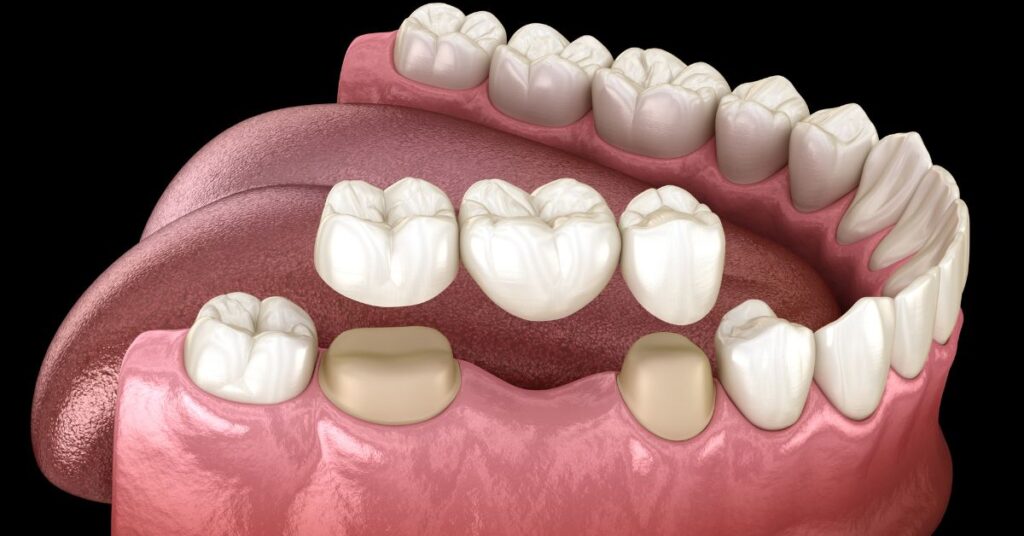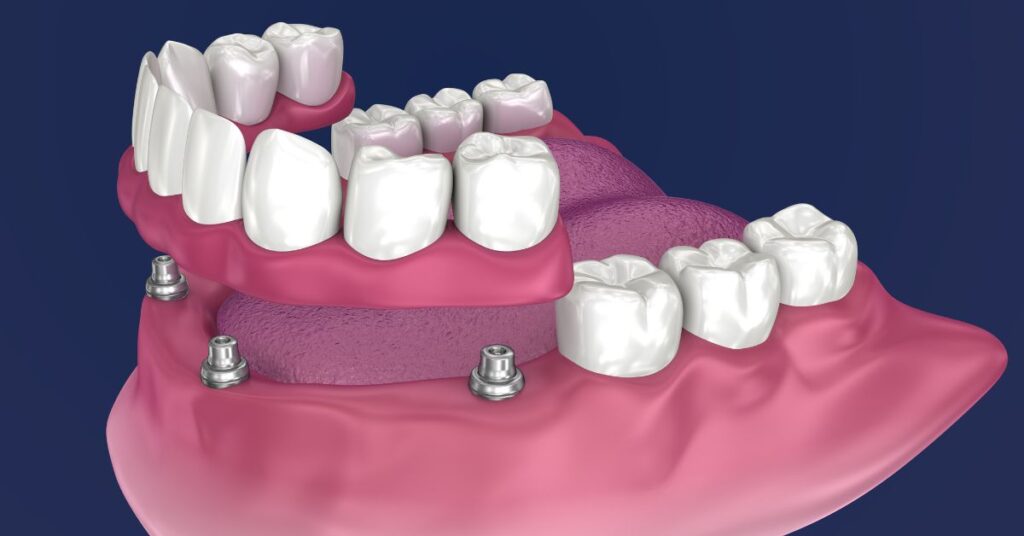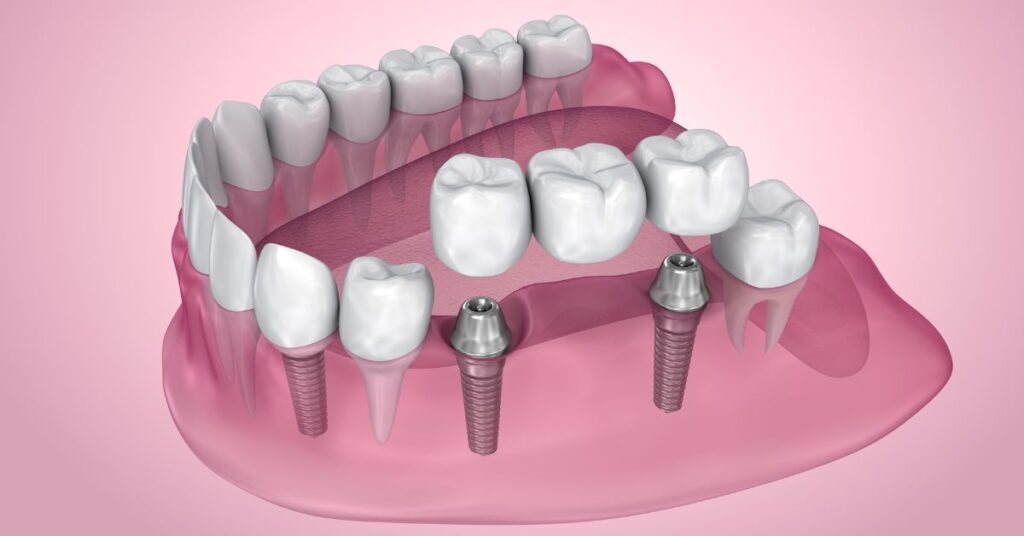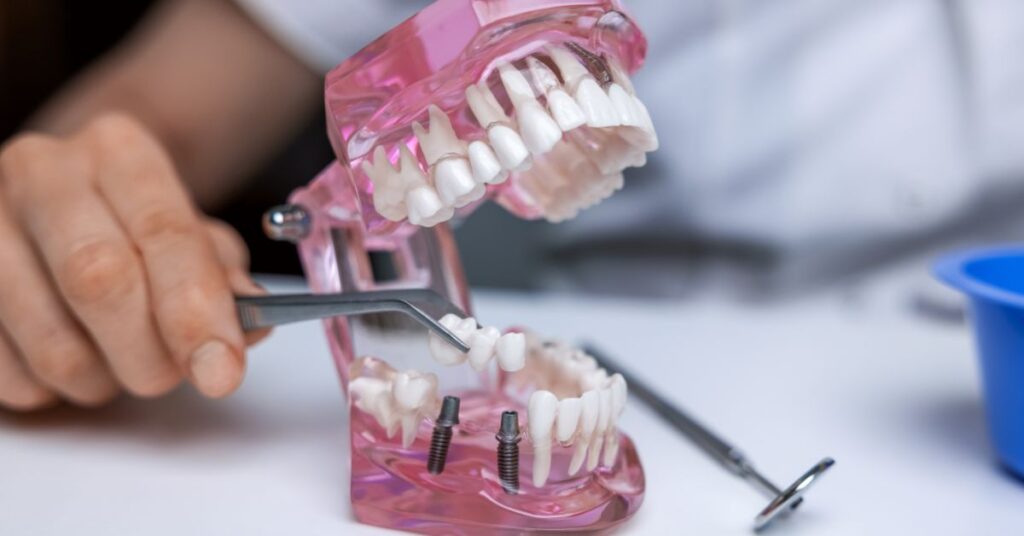
Introduction to Dental Bridges: Restoring Smiles and Function
Missing teeth can be a source of discomfort, affecting not only your smile but also your ability to eat, speak, and maintain oral health. Dental bridges offer a permanent solution to restore both function and aesthetics, bridging the gap between missing teeth and their natural counterparts. They are fixed dental restorations that consist of a false tooth, known as a pontic, which is held in place by crowns fitted over adjacent teeth called abutments.
The Anatomy of a Dental Bridge: A Bridge to a Healthy Smile
A dental bridge is a carefully crafted structure that mimics the natural arrangement of teeth. It comprises three main components:
- Abutment Teeth: These are the natural teeth that serve as anchors for the dental bridge. They are prepared by reshaping their surfaces to accommodate dental crowns.
- Pontic: The pontic is the false tooth that fills the gap created by the missing tooth. It is typically made of porcelain or a combination of porcelain and metal, ensuring a natural-looking appearance that blends seamlessly with the surrounding teeth.
- Framework: The framework connects the abutment crowns and the pontic, providing a sturdy foundation for the entire dental bridge. It is often made of a strong metal alloy that can withstand chewing forces.
Types of Dental Bridges: A Bridge for Every Smile
Dental bridges come in various types, each suited for specific clinical situations:
- Traditional Fixed Bridges: These are the most common type of dental bridges, relying on crowns placed on adjacent teeth for support. They are suitable for replacing one or more missing teeth when healthy abutment teeth are present on either side of the gap.
- Cantilever Bridges: Cantilever bridges are used when there is only one healthy abutment tooth available. The pontic extends beyond the last abutment tooth, relying on a metal wing or extension for additional support. However, their use is limited due to increased stress on the abutment tooth.
- Implant-Supported Bridges: When natural abutment teeth are not available or are not suitable for supporting a dental bridge, dental implants can be used as anchors. Implants are surgically placed in the jawbone, providing a stable foundation for the bridge.
The Benefits of Dental Bridges: A Comprehensive Overview

Dental bridges offer a multitude of benefits that go beyond simply filling the gap left by missing teeth. They provide a comprehensive solution for restoring oral health and overall well-being:
Restoring Chewing Function: Enjoying Food Without Limitations
Missing teeth can significantly impair chewing ability, making it difficult to eat certain foods and enjoy meals. Dental bridges restore chewing function by providing a stable surface for biting and grinding food, allowing individuals to eat comfortably and without restrictions.
Enhancing Speech and Communication: Speaking Clearly and Confidently
Missing teeth can affect speech clarity, causing difficulty in pronouncing certain sounds and leading to self-consciousness during communication. Dental bridges restore proper tooth placement and support, improving speech articulation and enabling individuals to speak clearly and confidently.
Maintaining Facial Structure: Preserving Your Natural Smile
Missing teeth can contribute to bone loss in the jaw, leading to changes in facial structure and a sunken appearance around the mouth. Dental bridges prevent bone loss by stimulating the jawbone and supporting the surrounding tissues, preserving the natural contours of the smile.
Restoring Self-Esteem and Confidence: Smiling Without Inhibitions
Missing teeth can negatively impact self-esteem and confidence, causing individuals to feel self-conscious about their smiles. Dental bridges restore a natural-looking smile, boosting self-esteem and confidence, and allowing individuals to smile freely and without inhibitions.
Dental Bridges vs. Alternatives: Making an Informed Choice

Dental bridges are not the only option for replacing missing teeth. Other treatment options include dental implants and dentures, each with its own advantages and disadvantages. It is crucial to understand the nuances of each option to make an informed decision based on individual needs and preferences.
Dental Implants: A Permanent Solution with Osseointegration
Dental implants are considered the gold standard for tooth replacement due to their long-term stability, biocompatibility, and ability to preserve bone health. They function like natural teeth, with a titanium screw surgically inserted into the jawbone, serving as an anchor for a dental crown.
Advantages of Dental Implants:
- Long-Term Stability: Dental implants provide a permanent and stable solution for replacing missing teeth, offering a predictable and reliable outcome.
- Preserving Bone Health: Dental implants stimulate the jawbone, preventing bone loss and maintaining facial structure.
- Natural Appearance and Function: Dental implants closely mimic the natural appearance and function of teeth, allowing for comfortable chewing and speaking.
- Individual Tooth Replacement: Dental implants can replace single or multiple missing teeth without compromising adjacent teeth.
Disadvantages of Dental Implants:
- Higher Initial Cost: Dental implants typically have a higher initial cost compared to other tooth replacement options.
- Surgical Procedure: Implant placement requires a surgical procedure, which may involve a longer treatment time and potential post-operative discomfort.
- Healing Period: A healing period of several months is often required for the implant to integrate with the jawbone before a crown can be attached.
Dentures: A Removable Option for Multiple Missing Teeth
Dentures are removable appliances that replace missing teeth and restore the function of chewing and speaking. They are typically made of acrylic resin and may include artificial teeth and a supporting framework.
Advantages of Dentures:
- Removable Option: Dentures offer the convenience of being removable, allowing for easy cleaning and maintenance.
- Cost-Effective: Dentures are generally less expensive compared to dental implants or fixed bridges.
- Replacing Multiple Missing Teeth: Dentures can replace multiple missing teeth, including a full arch of teeth.
Disadvantages of Dentures:
- Bone Loss: Dentures can contribute to bone loss in the jaw over time due to lack of stimulation.
- Stability Issues: Dentures may shift or dislodge during eating or speaking, causing discomfort and social embarrassment.
- Limited Chewing Ability: Dentures may not restore chewing function to the same level as natural teeth, making it difficult to eat certain foods.
Factors Influencing Treatment Choice: A Personalized Approach
The decision between dental bridges, implants, and dentures depends on various factors, including:
- Number of Missing Teeth: The number of missing teeth and their location influence the suitability of each treatment option.
- Jawbone Health: Adequate jawbone density is crucial for the success of dental implants, while dentures may be suitable for individuals with limited bone support.
- Individual Preferences: Patient preferences, financial considerations, and overall oral health status also play a significant role in the treatment decision.
Dental Bridge Procedure: A Step-by-Step Guide

The dental bridge procedure typically involves multiple appointments to ensure proper planning, preparation, and placement of the bridge. Here’s a step-by-step guide to the dental bridge procedure:
Initial Consultation and Treatment Planning
- Consultation: The initial consultation involves a thorough dental examination to assess your oral health, jawbone condition, and suitability for a dental bridge.
- Treatment Planning: Your dentist will discuss the treatment options, including dental bridges, and explain the procedure in detail. They will also address any concerns and answer your questions.
- Anesthesia Discussion: Anesthesia options will be discussed, such as local anaesthesia or general anaesthesia, depending on the extent of the procedure and your preferences.
Abutment Tooth Preparation
- Local Anesthesia: Before preparing the abutment teeth, local anaesthesia will be administered to numb the area and minimize discomfort.
- Tooth Shaping: The dentist will carefully reshape the enamel and dentin of the abutment teeth, creating a space for the dental crowns.
- Impressions: Impressions of the prepared abutment teeth will be taken to create precise moulds for the fabrication of the dental crowns.
Temporary Bridge Placement
- Temporary Crowns: Temporary crowns will be placed on the prepared abutment teeth to protect them and provide a natural-looking appearance during the fabrication of the permanent bridge.
- Dietary Instructions: Your dentist will provide dietary instructions to minimize stress on the temporary crowns and prevent discomfort.
Permanent Bridge Fabrication
- Dental Laboratory: The impressions and moulds are sent to a dental laboratory, where skilled technicians will craft the permanent dental bridge.
- Pontic Creation: The pontic, the false tooth that fills the gap, is meticulously crafted from porcelain or a combination of porcelain and metal, ensuring a natural-looking finish.
- Framework Fabrication: The framework, the metal base that supports the pontic and connects the crowns, is fabricated with precision.
Permanent Bridge Placement
- Local Anesthesia: Local anaesthesia will be administered to numb the area before removing the temporary crowns.
- Permanent Bridge Fitting: The permanent dental bridge is carefully fitted onto the prepared abutment teeth, ensuring a precise and comfortable fit.
- Adjustments: Minor adjustments may be made to optimize the fit, bite, and aesthetics of the dental bridge.
- Final Checks: Your dentist will thoroughly inspect the bridge, ensuring its stability, function, and aesthetic appearance.
Post-operative Care and Follow-ups
- Post-operative Instructions: Your dentist will provide post-operative instructions, including pain management, oral hygiene practices, and dietary recommendations.
- Follow-up Appointments: Regular follow-up appointments are essential to monitor the healing of the abutment teeth, the health of the surrounding gums, and the overall success of the dental bridge.
Dental Bridge Care: Maintaining a Healthy Smile

Dental bridges, like natural teeth, require proper care and maintenance to ensure their longevity and prevent complications. Here’s a comprehensive guide to dental bridge care:
Oral Hygiene Practices: Keeping Your Bridge and Smile Clean
Maintaining good oral hygiene is crucial for the long-term success of your dental bridge and overall oral health. Follow these daily practices:
- Brushing: Brush your teeth twice daily, using a soft-bristled toothbrush and fluoride toothpaste. Gently clean all surfaces of the teeth, including the bridge, paying attention to the areas where the bridge meets the gums.
- Flossing: Flossing once a day is essential to remove plaque and food particles from the areas between teeth and under the bridge, where a toothbrush cannot reach. Use a floss threader or a special interdental brush to clean under the bridge.
- Mouthwash: Using an antiseptic mouthwash can help control plaque buildup and freshen your breath. Consult your dentist for recommendations on mouthwash selection.
Regular Dental Checkups: Preventive Care for Long-Term Success
Regular dental checkups are essential for monitoring the health of your dental bridge, surrounding teeth, and gums. Your dentist will:
- Examine the Bridge: Check the bridge for any signs of wear, looseness, or damage.
- Assess Gum Health: Inspect the gums surrounding the abutment teeth and under the bridge for signs of inflammation or gum disease.
- Clean the Bridge: Professionally clean the bridge to remove plaque and tartar buildup.
- Address Underlying Issues: Identify and address any underlying dental problems that could affect the bridge’s stability or longevity.
Lifestyle Habits: Contributing to Bridge Longevity
Certain lifestyle habits can contribute to the longevity and success of your dental bridge:
- Avoid Excessive Force: Avoid biting on hard objects, such as ice or pens, as this can strain the bridge and cause damage.
- Maintain a Healthy Diet: A balanced diet with adequate calcium and vitamins supports bone health and overall oral health.
- Quit Smoking: Smoking increases the risk of gum disease and bone loss, which can negatively impact the bridge’s stability.
- Manage Chronic Conditions: If you have chronic conditions like diabetes, follow your doctor’s recommendations to control your blood sugar levels, as diabetes can affect gum health.
Additional Tips for Dental Bridge Care
- Nightguards: If you clench or grind your teeth at night, a custom-fitted nightguard can protect your bridge from excessive wear and tear.
- Dental Insurance: Dental insurance can help cover the costs of regular dental checkups, cleanings, and any necessary repairs or adjustments to your dental bridge.
- Prompt Response to Issues: If you notice any changes in your dental bridge, such as looseness, discomfort, or chipped porcelain, contact your dentist promptly for evaluation and treatment.
Conclusion:
Dental bridges offer a transformative solution for restoring smiles, enhancing function, and boosting self-confidence. They are a valuable addition to the realm of restorative dentistry, providing a permanent and aesthetically pleasing option for replacing missing teeth.
Recapping the Benefits of Dental Bridges: A Transformative Solution
Dental bridges provide a multitude of benefits that extend beyond simply filling the gap left by missing teeth:
- Restoring Chewing Function: Dental bridges restore the ability to eat comfortably and without restrictions, improving overall nutrition and well-being.
- Enhancing Speech and Communication: Dental bridges enable clear and confident speech, enhancing communication and social interactions.
- Maintaining Facial Structure: Dental bridges prevent bone loss and preserve facial contours, maintaining a youthful appearance.
- Restoring Self-Esteem and Confidence: Dental bridges restore a natural-looking smile, boosting self-esteem and social confidence.
Embracing a Brighter Smile: The Confidence to Smile Wide
Dental bridges not only restore the physical structure of your smile but also have a profound impact on your psychological well-being. By addressing missing teeth and enhancing your smile, dental bridges can:
- Increase Confidence in Social Settings: A confident smile enhances social interactions and empowers individuals to engage more freely in personal and professional settings.
- Improve Emotional Well-being: A positive self-image and a sense of satisfaction with one’s appearance can contribute to overall emotional well-being and happiness.
- Enhance Quality of Life: Dental bridges can significantly improve the quality of life by restoring function, boosting confidence, and promoting overall well-being.
